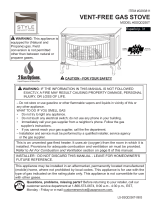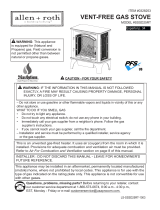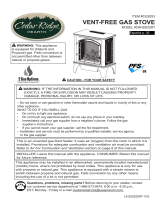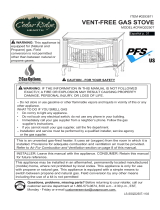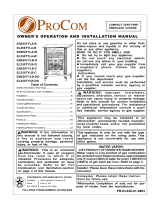
4
SAFETY INFORMATION
1. This appliance is only for use with the type of gas indicated on the rating plate. This appliance is
not convertible for use with other gases.
2.
Do not place propane/LP supply tank(s) inside any structure. Locate propane/LP supply tank(s) outdoors.
3. If you smell gas
• shut off gas supply
• do not try to light any appliance
• do not touch any electrical switch; do not use any phone in your building
• immediately call your gas supplier from a neighbor’s phone. Follow the gas supplier’s instructions
• if you cannot reach your gas supplier, call the re department
4. This heater shall not be installed in a bedroom or bathroom.
5. Do not use this heater as a wood-burning heater. Use only the logs provided with the heater.
6. Do not add extra logs or ornaments such as pine cones, vermiculite or rock wool. Using these
added items can cause sooting. Do not add lava rock around base. Rock and debris could fall into
the control area of heater.
7. This heater is designed to be smokeless. If logs ever appear to smoke, turn off heater and call a
qualied service person. Note: During initial operation, slight smoking could occur due to log curing
and heater burning manufacturing residues.
8. To prevent the creation of soot, follow the instructions in Cleaning and Maintenance, page 21-22.
9. Before using furniture polish, wax, carpet cleaner or similar products, turn heater off. If heated,
the vapors from these products may create a white powder residue within burner box or on adjacent
walls or furniture.
10. This heater needs fresh air ventilation to run properly. This heater has an Oxygen Depletion
Sensing (ODS) safety shutoff system. The ODS shuts down the heater if not enough fresh air is
available. See Air for Combustion and Ventilation, page 8. If heater keeps shutting off, see
Troubleshooting, page 23-25.
11. Do not run heater
• where ammable liquids or vapors are used or stored.
• under dusty conditions.
12. Do not use this heater to cook food or burn paper or other objects.
13. Never place any objects in the heater or on logs.
14. Do not use heater if any part has been under water. Immediately call a qualied service technician to
inspect the room heater and to replace any part of the control system and any gas control which has
been under water.
15. Turn off and unplug heater and let cool before servicing. Only a qualied service person should
service and repair heater.
16. Operating heater above elevations of 4,500 feet could cause pilot outage.
17.
Do not operate heater if log is broken. Do not operate heater if log is chipped (dime-sized or larger).
18. To prevent performance problems, do not use propane/LP fuel tank of less than 100 lb. capacity.
19. Provide adequate clearances around air openings.
QUALIFIED INSTALLING AGENCY
Only a qualied agency should install and
replace gas piping, gas utilization equip-
ment or accessories, and repair and equip-
ment servicing. The term "qualied agency"
means any individual, rm, corporation, or
company that either in person or through a
representative is engaged in and is respon-
sible for:
a) Installing, testing, or replacing gas piping or
b)Connecting, installing, testing, repairing, or
servicing equipment; that is experienced in
such work; that is familiar with all precautions
required; and that has complied with all the re-
quirements of the authority having jurisdiction.





















